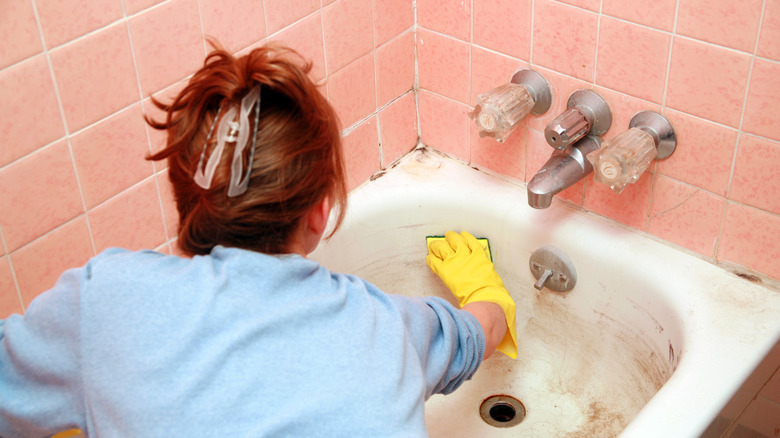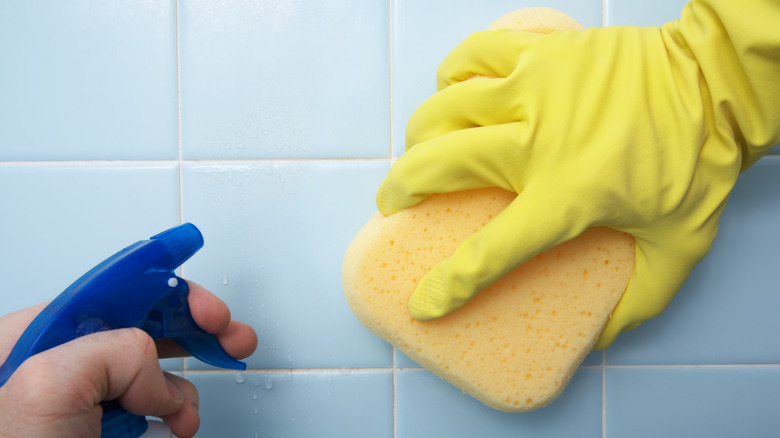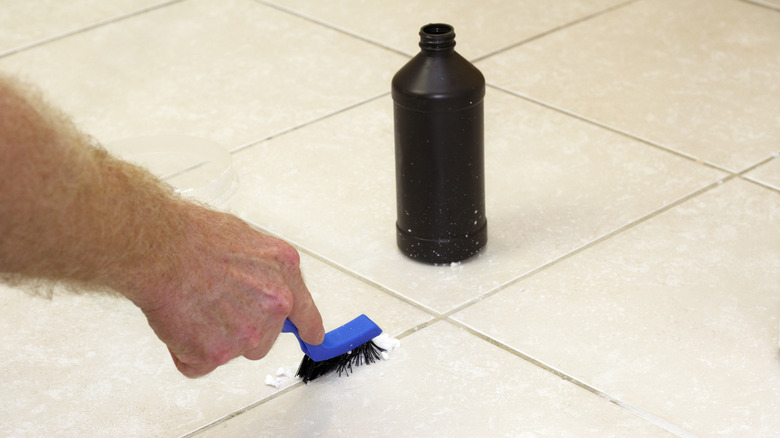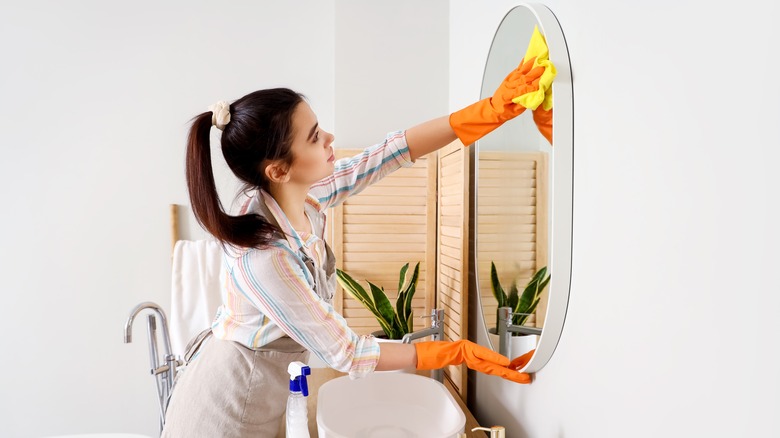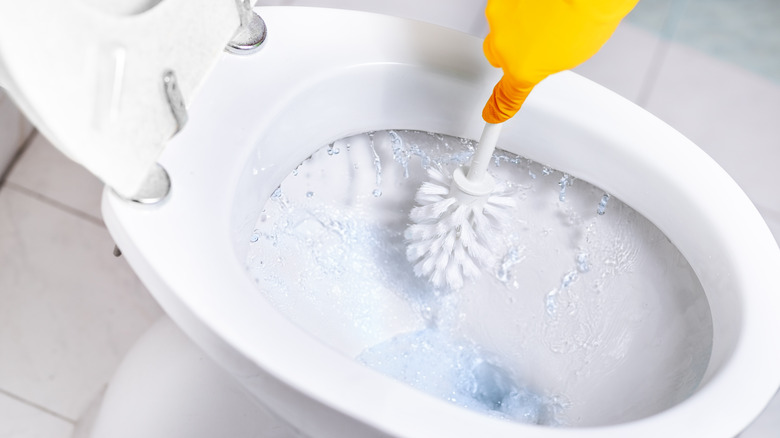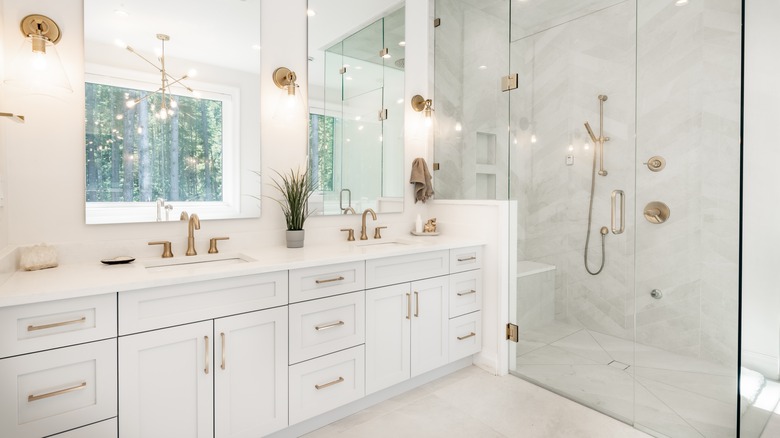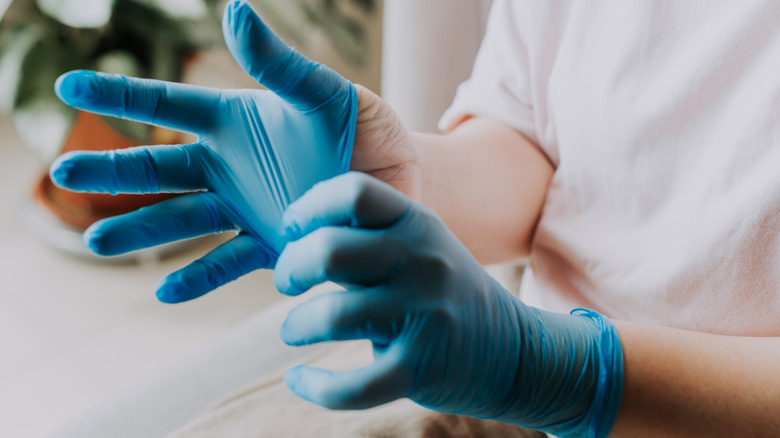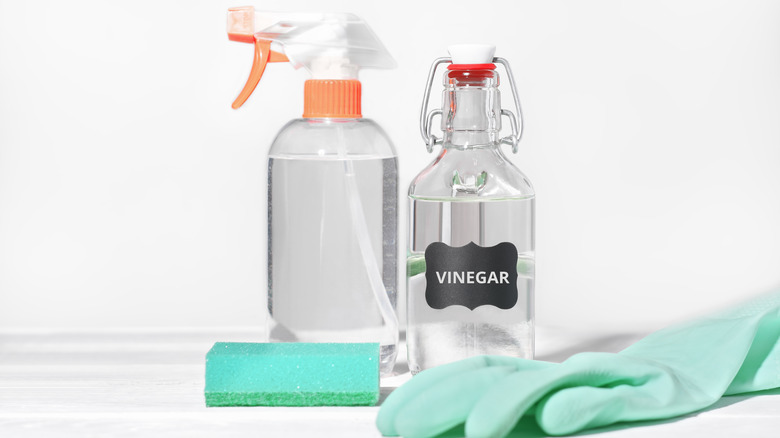5 Ways To Use Hydrogen Peroxide In Your Bathroom, And 2 Ways To Avoid
While hydrogen peroxide is certainly a staple in home medicine cabinets and professional medical facilities alike, it has many other valuable uses that may surprise you. In the laundry room, it's a powerful ally against stubborn household stains, but it also possesses impressive sanitizing capabilities, making it the perfect solution for bathroom messes.
Its effectiveness all boils down to good 'ol chemistry. The chemical makeup of hydrogen peroxide is water, H2O, plus an extra molecule of oxygen, to become H2O2. The power comes from that extra oxygen molecule, because its oxidation kills germs. Some of the hacks we'll share use a simple bottle of hydrogen peroxide that you can pick up at any store or pharmacy. Others include some additional scrubbing power from baking soda — the two form a cleaning dream team — but we'll be sure to call that out each time. Read on for all the best ways to use hydrogen peroxide in your bathroom, plus two things to avoid.
Remove grime from your shower
Grimy residue in the shower is inevitable thanks to the constant combination of soap scum, moisture, and lack of airflow. However, staying on top of cleaning will mean less build up overall and less time scrubbing for you. While there are plenty of potent cleaning products available for the shower, many contain harsh, pungent chemicals. Hydrogen peroxide offers a powerful clean without the noxious fumes. Its chemical makeup kills mold, bacteria, fungi, and viruses by breaking down their proteins.
When you're ready to clean your shower, grab a bottle of hydrogen peroxide (make sure it's not expired), some baking soda, a scrub brush, and rubber gloves to protect your hands. Spray down the shower walls, floor, and any little nooks and crannies. Next, sprinkle some baking soda to form a paste with the hydrogen peroxide. Allow the mixture to bubble and foam for several minutes, then scrub. After a rinse with clean water, you'll be amazed by the sparkling results, and always want to keep a bottle of hydrogen peroxide in your shower.
Brighten dingy grout
While light-colored grout helps tile designs pop and makes your bathroom feel bright and fresh, it's notoriously difficult to keep clean. Retailers offer a slew of grout cleaning products, but rather than spending $10-$20 per bottle, look no further than your medicine cabinet. You don't need all those other chemical concoctions when hydrogen peroxide is a highly effective cleaner of dingy, discolored grout. Not only will you kill any bacteria lurking around the tile, but you'll see the bubbles work their brightening magic. Even commercial cleaning companies recommend a combination of hydrogen peroxide and baking soda as the best grout cleaner.
To begin, don a pair of rubber gloves, then mix one cup of baking soda with one cup of hydrogen peroxide. Spoon the pasty mixture onto your grout and let it sit for several minutes. Come back with a skinny scrub brush or an old toothbrush, and scrub. If the mixture gets onto the surrounding tile, that's just an added, sanitizing bonus. Rinse the remaining residue with clean water.
Clean the mirror
From toothpaste splatter to perfume overspray to regular splashing from the sink, our bathroom mirrors take a beating. While some commercial glass cleaners use vinegar as the main ingredient, others feature harsh ammonia. So if you're looking for a way to clean your mirrors or windows without streaks or harsh odors, reach for that trusty bottle of hydrogen peroxide. Surface care experts recommend the solution as a natural, yet powerful, alternative to harsher products on the market, plus it's affordable and easy to find.
To clean your bathroom mirror or window, you'll need a pair of rubber gloves, a clean, empty spray bottle, hydrogen peroxide, and a microfiber cloth. After you've put on the gloves, fill your spray bottle with hydrogen peroxide, and then spritz it onto the cloth. Surprisingly, experts advise spraying on the cloth rather than directly onto the mirror to help prevent water spots. Wipe down the mirror, and repeat if necessary.
Sanitize the toilet
Let's be honest: cleaning the toilet is a chore we all wish we could take off our lists. Unfortunately, it's a necessary evil to keep harmful germs at bay, and our bathrooms smelling fresh. If you're always on the hunt for the best toilet cleaning hacks, we've got a new one you'll want to try next time you're gathering supplies to scrub the commode. We already know that hydrogen peroxide's chemical composition makes it a powerful antiseptic. So effective, in fact, that Clorox's Healthcare Line (specifically designed for hospital use) has an array of hydrogen peroxide disinfectant products.
While you may not need hospital-grade sanitation in your home, you can rest easier knowing that there's a natural, odor-free cleaner just waiting in your medicine cabinet. You'll need rubber gloves, an empty (clean) spray bottle, hydrogen peroxide, and a toilet cleaning brush. Some retailers sell hydrogen peroxide in spray bottle form, so that's an excellent option for more convenient cleaning. To clean the inside of the toilet, spray liberally and allow the bubbles to work for 15-20 minutes before you begin scrubbing. You can also spray down the seat, base, lid, and any other surface that should be sanitized, give it time to work, and then wipe with a paper towel or microfiber cloth.
Safely clean countertops — even marble
While bathroom countertop materials can range from laminate to solid surface to quartz to marble (and plenty in between), one thing remains true, regardless of the material: they all get dirty and need to be cleaned on a regular basis. Instead of investing in pricey countertop cleaners, all you need is some hydrogen peroxide. It will sanitize, cut through grimy residue, and tackle stains. However, if your countertops are dark in color, proceed with caution, and test in a small, inconspicuous area first. Otherwise the hydrogen peroxide could bleach out some of the color.
Once you've tested successfully and have the green light to go ahead, all you'll need is a spray bottle of hydrogen peroxide and a clean, microfiber cloth. Wipe away any loose debris on the surface, and then spray. Allow it to sit for several minutes to disinfect, and then wipe with the microfiber cloth. Depending on your countertop material, you may want to use this hack sparingly, or reserve it for extra tough cleanings. Experts give mixed advice on whether long term use of hydrogen peroxide on more delicate materials, like marble, could break down the sealant.
Don't use it without wearing gloves
Even though hydrogen peroxide doesn't emit the powerful fumes of other cleaning products or came with the same frightening warning label, that doesn't mean it's free of any risks. And while there are so many surprising ways to use hydrogen peroxide in your home, caution is still needed. A big mistake people make when using the solution around the house is not properly protecting their skin. Most medical-grade hydrogen peroxide that's available on retail shelves comes in a 3% concentration. Higher concentrations are used in industrial settings and much more likely to burn skin, but caution should be used regardless. Exposure to skin can cause blisters, chemical burns, or even turn fingertips white.
To avoid any of these painful problems, always wear rubber gloves before you begin cleaning with hydrogen peroxide. According to the CDC, children's skin is even more susceptible to burns from hydrogen peroxide, so store it well out of the reach of any little ones in the household, and never let them help with cleaning chores when using the product. Make sure your hands are protected, and take care not to splash as you're cleaning so that it doesn't get into your eyes.
Don't mix with vinegar cleaners
While vinegar is another beloved natural cleaner and cult favorite for good reason, there are certain instances when it should never be used. A prime example of this is mixing it with hydrogen peroxide while cleaning. When these two powerhouses are combined, they form peracetic acid. It's a corrosive substance that can damage surfaces but, more importantly, can harm the eyes, nose, throat, lungs, and skin. Its effects take hold quickly, with research showing extreme discomfort and upper respiratory irritation in humans after only three minutes of low exposure.
To prevent any harm to your health or home, never mix the two. Instead, a safe alternative to mix with hydrogen peroxide is baking soda. Their chemical reaction is responsible for breaking apart greasy residue and organic molecules. When combined, the two form a paste that works wonders on stains, soap scum, and many messes in between. Plus, the grittiness of the paste packs a punch when it comes to scouring extra stubborn residue.
